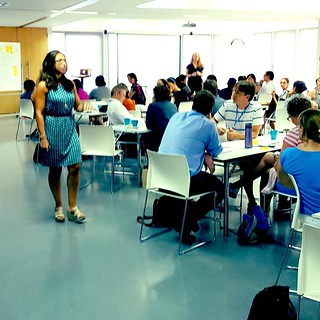Over the course of this academic year, I have been very fortunate to work with a wide variety of schools – from public schools in the US to private schools in Singapore to international schools all around Asia.
 In the US, my focus has been with Marysville School District (MSD) about 45 minutes north of Seattle. My company, Eduro Learning (along with Jeff, Chrissy, Clint, Madeleine and Simon), has a long term contract with MSD to provide all of their on-site professional development over the next five years to support their first one-to-one laptop program. Plus, we are super excited to be adding another Washington State school district to our US-based training, with the addition of Everett School District beginning next academic year. Along with these long term consulting contracts, we’ve also run several conferences, called Eduro Learning Institutes in Washington state this academic year, so we’ve gotten to know a number of districts around the state.
In the US, my focus has been with Marysville School District (MSD) about 45 minutes north of Seattle. My company, Eduro Learning (along with Jeff, Chrissy, Clint, Madeleine and Simon), has a long term contract with MSD to provide all of their on-site professional development over the next five years to support their first one-to-one laptop program. Plus, we are super excited to be adding another Washington State school district to our US-based training, with the addition of Everett School District beginning next academic year. Along with these long term consulting contracts, we’ve also run several conferences, called Eduro Learning Institutes in Washington state this academic year, so we’ve gotten to know a number of districts around the state.
 In Singapore, I have been working with Apple to provide pedagogical-based training for several different public and private schools that are established as one-to-one leaders within Singapore. These trainings have been designed to highlight key areas of success in these high performing schools, and to provide opportunities to reflect and focus on the most effective pedagogical approaches for learning with technology.
In Singapore, I have been working with Apple to provide pedagogical-based training for several different public and private schools that are established as one-to-one leaders within Singapore. These trainings have been designed to highlight key areas of success in these high performing schools, and to provide opportunities to reflect and focus on the most effective pedagogical approaches for learning with technology.
On the international school circuit, I have been working with NIST International School to support their technology coaches, as well as the leadership team in developing a strong coaching culture at the school. Along with NIST, I’ve continued my work with Saigon South International School, and led a number of workshops and keynotes in the region, including leading the Learning2 Asia team, over the course of the year.
I have to admit, at the beginning of this academic year, I was a little apprehensive. There would be a lot of traveling, I wouldn’t have my own classroom, and I haven’t spent time in US public schools in quite a while. I had no idea if these three different elements of my work would complement each other, or be a constant source of tension. I did know that there were plenty of weeks where I would fly in from another country in Asia, straight back out again to the US, and be back at NIST a day or two after I arrived from Seattle. Would all of that context switching make me crazy?
5 Key Elements for Success in a 1:1 Learning Environment
In actuality, my biggest surprise take away from all of this seemingly divergent work, was that all of these schools are more alike than different. In my work with all of these schools, we discovered that there are some key elements that are common throughout all the schools that are essential to the success of a one-to-one program.
It turns out that all of these unique communities in different countries, with different organizational structures, different constraints and expectations, and even different cultural understandings of what school should be, are actually more alike than different.
From school to school, the following key elements were highlighted by either admin, teachers, parents or myself as essential components to continue to build – whether the school is at the beginning of their one-to-one journey, or a more established program ready for review.
What you teach may be the same, but how you do it can change…
One of the challenges many teachers have been struggling with, is this idea of sticking to the curriculum, or meeting content goals for external exams.  When we have so many lessons documented and so many resources to work with, sometimes we can get trapped into seeing each lesson on its own, rather than a concept-based unit with an overall learning outcome.
When we have so many lessons documented and so many resources to work with, sometimes we can get trapped into seeing each lesson on its own, rather than a concept-based unit with an overall learning outcome.
Unfortunately, this leaves us with a feeling that we have to take each lesson as it stands and make it “technology rich”. What this ends up looking like in practice is taking each lesson at a time, and looking for ways to “infuse technology” into each lesson. Rather than seeing the learning outcome as the goal, and the path to get there the opportunity for transforming instruction.
So, a key takeaway for me is the need to refocus back on pedagogical practices: starting with the questions:
- what do you want students to know and be able to do at the end of this unit?

- what big learning do you want them to have that will go beyond the context of this course, and this grade level? How does this apply to the “real world”?
- what can students do to demonstrate their understanding of this big idea or concept?
These seem like easy questions to answer when you’re starting a unit from scratch, but if you have lots of documentation already in place, the answers often start with “well, currently we have students do xyz”, rather than a solid and concise understanding of what we want students to know and be able to do. And then we can get caught right back into the trap of looking at what we already do and trying to make it “tech-y”, rather than looking at the learning outcomes and seeing how we can achieve those same goals, but possibly follow a different path to get there.
It’s OK not to be perfect…
In all of these contexts, teachers and administrators want to do their best (this is not a surprise), but sometimes wanting to do our best is almost an obstacle to overcome. We work so hard to do our best possible job, that it can be very difficult to take a risk and try something new, even to admit when we don’t know something.
 For example, I have noticed that when asking teachers to try out a new tool, with very little direct instruction, they will often get very quiet, and many times just sit calmly waiting for the part of the session where I “teach” them how to use it. Doing the same thing with students elicits shouts of joy, jumping one part of the room to another to share and genuine excitement at what they are able to discover.
For example, I have noticed that when asking teachers to try out a new tool, with very little direct instruction, they will often get very quiet, and many times just sit calmly waiting for the part of the session where I “teach” them how to use it. Doing the same thing with students elicits shouts of joy, jumping one part of the room to another to share and genuine excitement at what they are able to discover.
As teachers, and maybe just as adults, we can be scared to admit what we don’t know. We are worried that others will think less of us when we ask a question, or if we are excited about something we just learned, that others may judge us from not having known it already.
What we need to create is an environment where learning is encouraged, risk taking is celebrated and everyone: from students, to teachers, to admin, demonstrate a growth mindset not only in what they say but the actions they take. As hard as it is for teachers to admit when they are wrong, it seems even harder for administrators to be role models in this process. Exposing vulnerability is not easy, but it is one of the ways we can keep ourselves open to learning and exploring and trying new things together – without being afraid to share what you don’t know.
Parents need support too…
So much of the work we do is with teachers and administrators, to support the learning that is happening in the classroom. Often times this means we can forget how much things have changed for parents as well. When we are giving students laptops, we’re also asking them to support the management of those devices at home. For many parents this may be a new experience – and with the added dimension of the laptops potentially being provided by the school, rather than purchased by the parents – they may not be sure exactly how much control they have over the devices.
 In all of the international schools I’ve worked in, we’ve facilitated parent training sessions on a regular basis, but not every school has staff (like coaches) on hand to facilitate these kinds of trainings, or parents may not be able to attend these kinds of sessions due to other conflicts or responsibilities. That doesn’t mean we can leave them to struggle on their own, though.
In all of the international schools I’ve worked in, we’ve facilitated parent training sessions on a regular basis, but not every school has staff (like coaches) on hand to facilitate these kinds of trainings, or parents may not be able to attend these kinds of sessions due to other conflicts or responsibilities. That doesn’t mean we can leave them to struggle on their own, though.
In some of the schools I’ve worked with this year, we’ve talked about: special evening sessions with the school or district Tech Director, websites built to provide resources that can support parents, hard copy newsletters and resources sent home throughout the year, special sessions for parents at the beginning of the school year when laptops are distributed, and a general expectation that teachers can have some of these kinds of conversations with parents too.
Along those lines, one of the things I’m really proud of is our new Eduro Learning: Parenting in the Digital Age certificate – it’s entirely online, designed for parents, and will be available starting in August 2016. Chrissy and I have been working on hard on developing a program that is relevant to both international school parents, and parents in public and private schools in their home country. We are super excited to see how parents react to the resources, interviews, activities and content we’ve compiled and created for them. As soon as it’s ready to go, we’ll share more, of course!
Schools need to tell their story…
We’re all proud of our schools, our students, and our community. Students in our schools are engaged in outstanding learning experiences on a daily basis, but these are rarely documented or shared outside the individual classroom in a purposeful way.  Schools as a whole, administrators and teachers, can (and should), be regularly highlighting the amazing work of both our students and our teachers in spaces that connect within and beyond our immediate school community.
Schools as a whole, administrators and teachers, can (and should), be regularly highlighting the amazing work of both our students and our teachers in spaces that connect within and beyond our immediate school community.
We may feel that social media is not a valid form of communication about our school, that our newsletters or website or “official” correspondence tells the story of our school community to our school community. But, the reality is that if you’re not telling the story of your school, someone else is – whether it’s students posting media and tagging the school, or parents sharing in their social media spaces, there is always someone sharing something.
So, if schools want to ensure that they are both appreciating and sharing the amazing work of their teachers and students, and owning the story of their school, they need to plan, coordinate and purposefully share their story with intention and focus – rather than let someone else tell the story for them.
We need to be connected…
One consistent message I have heard from every school I’ve worked in this year, is the need for teachers and administrators to have opportunities to connect, collaborate and share ideas that work – in their very specific context.  It’s wonderful and amazing to have access to a global network of educators sharing and supporting each other in social media spaces, but we need to find ways to prioritize the time to work together as a face-to-face team within the district or the school, where everyone has a clear understanding of the unique circumstances of this particular environment.
It’s wonderful and amazing to have access to a global network of educators sharing and supporting each other in social media spaces, but we need to find ways to prioritize the time to work together as a face-to-face team within the district or the school, where everyone has a clear understanding of the unique circumstances of this particular environment.
We all have had that experience of a teacher doing something amazing in the classroom next door and never hearing about it until a student talks about it, or it gets mentioned in the faculty lounge. We need to find ways to build in time for teachers (and administrators) to regularly and purposefully share with each other, so that we can tap into the great work that’s happening right next door!
More Alike Than Different
It has been such an honor and a pleasure to be able to work in all of these different contexts over the course of this year. And, for me, such a fascinating discovery to find that these schools, for all of their uniqueness, are really so similar. 
We can get so caught up in talking about the differences in the details of our one-to-one programs, like the budget that one school has compared to another, or the devices that one district chooses to buy, or the staffing we have, or even the standardized tests our students are subject to. But really, none of those are as important in the growth of any one-to-one program, as is establishing and developing these foundational elements that all schools can implement successfully in their own context.
I have especially enjoyed having essentially one, long, interconnected conversation with teachers and administrators in so many different countries. Being able to tell stories from Marysville in Singapore, and seeing how experiences in Bangkok have helped me highlight different ideas in Seattle has honestly been so much fun. And most of all, it’s wonderful to see that the individualized work I’ve been doing in each of these schools connects to, and enhances, the work in all of the other communities. I love that we’re all so much more alike than we are different.
Image Credits
- Beautiful sunrise today, Seattle by superkimbo, Creative Commons licensed on Flickr
- Now, that’s how you do a sidewalk! by superkimbo, Creative Commons licensed on Flickr
- 36 – High Five by Melanie, Creative Commons licensed on Flickr
- saturated mosaic by janet lackey, Creative Commons licensed on Flickr
- path by Nate & Tilly Ritter, Creative Commons licensed on Flickr
- bride with a mirror by mahmoud99725, Creative Commons licensed on Flickr
- In action at a parent coffee morning at NIST by Brian Duffy, shared with permission by superkimbo, Creative Commons licensed on Flickr
- Megaphone by Tennesse Journalist, Creative Commons licensed on Flickr
- One girl whispering secrets to another little girl by Personal Creations, Creative Commons licensed on Flickr
- pea pod by Madeleine, Creative Commons licensed on Flickr





